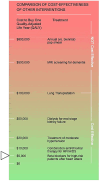Community-involved economic evaluation and development of a cost-effectiveness calculator for two peer-driven substance use interventions
- PMID: 41018778
- PMCID: PMC12460232
- DOI: 10.3389/fpubh.2025.1519980
Community-involved economic evaluation and development of a cost-effectiveness calculator for two peer-driven substance use interventions
Abstract
Introduction: While peer-driven substance use interventions have proliferated across the U.S., economic evaluations of these interventions have lagged behind. A key characteristic of these interventions is the centrality of the "nothing about us without us" ethos, which should extend into economic evaluation research. To that end, this study sought to take a community-based participatory research (CBPR) approach to conducting a cost-effectiveness analysis (CEA) of peer recovery support services (PRSS) and turning that CEA and a CEA of bystander naloxone distribution (BND) into components of a free, web-based calculator for use by recovery community centers (RCCs).
Methods: We engaged staff and administrators (n = 10) at two RCCs as community partners. We developed preliminary analytic models for the CEAs and engaged the RCCs in a feedback session to inform the final CEA models. We then built prototype calculators and pre-tested them with our community partners. After integrating all feedback, we launched the pilot calculator for PRSS and BND CEA and have continued to collect feedback.
Results: Our RCC community partners substantively and meaningfully engaged in the co-creation of the CEA calculator and the analytic model. Calculator users have largely rated the calculator somewhat to very easy to use (58.33% and 29.17%, respectively), and rated the interpretability of results as neutral (25%), somewhat easy (45.83%) to very easy (20.83%), while finding the required information to input into the calculator was more challenging, with 8.33% rating it very difficult, 4.17% somewhat difficult, 37.5% neutral, 41.67% somewhat easy, and only 8.33% rating it very easy. There was broad agreement that calculator results would be useful for their organizations (20.83% neutral, 41.67% somewhat useful, 37.5% very useful).
Discussion: RCCs face known challenges with data collection and management. This study was limited by its size (10 live participants and 24 post-launch feedback surveys). However, feedback is continuing to be collected, and a larger-scale future study is planned.
Conclusion: This project demonstrates that it is feasible to take a CBPR approach to economic evaluation, and that both scholarly research and easily-interpretable tools can be created from such an approach that mutually benefits researchers and community organizations.
Keywords: community-based participatory research; community-involved research; cost-effectiveness analysis; economic evaluation; peer recovery support services.
Copyright © 2025 Castedo de Martell, Moore, Wang, Holleran Steiker, Wilkerson, McCurdy, Ranjit and Brown.
Conflict of interest statement
SCM was an uncompensated board member for an organization that provided feedback and served as a part-time contractor providing evaluation services for the second organization providing feedback during the study period. The remaining authors declare that the research was conducted in the absence of any commercial or financial relationships that could be construed as a potential conflict of interest.
Figures



References
-
- Barnett PG, Hui SS. The cost-effectiveness of methadone maintenance. Mt Sinai J Med. (2000) 67:365–74. Avaialble at: https://pubmed.ncbi.nlm.nih.gov/11064486/ - PubMed
MeSH terms
Substances
LinkOut - more resources
Full Text Sources
Medical

